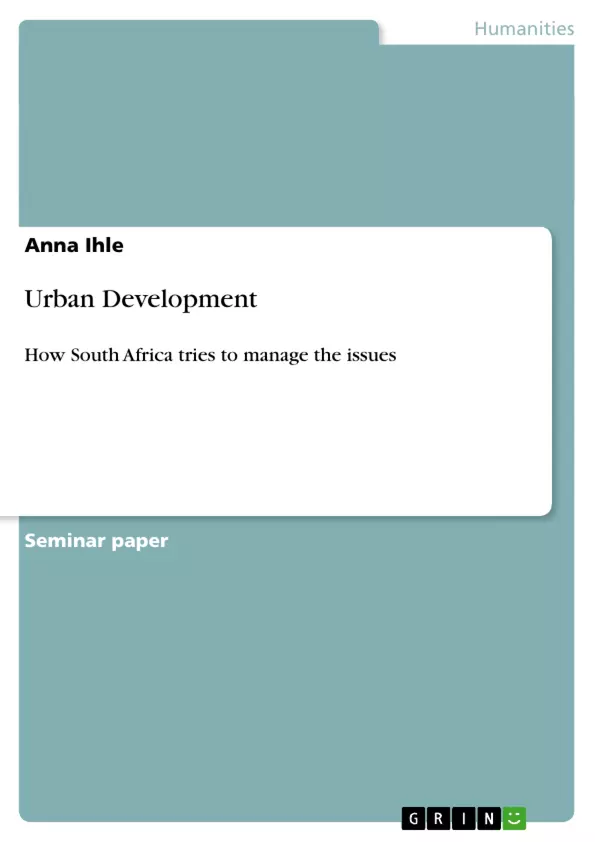[...] The paper describes the situation in which the country was after several decades of Apartheid policy. It focuses especially on the problematic issue of housing. The introduction outlines the Urban Development Strategy with its goals and visions as well as its direct criticism. Subsequent to that, the discussion emphasizes the two main issues urban development planning is confronted with namely housing and infrastructure. After that there follows a short chapter on the problematic situation of implementing theory. The final part of the discussion not only concludes and summarises the main aspects, but presents a possible outlook for future urban development in the South African context.
Inhaltsverzeichnis (Table of Contents)
- Introduction
- Urban Reality during and after Apartheid
- General Situation
- Housing and Infrastructure
- The Urban Development Strategy
- Prologue, Vision and Goals
- Criticism
- Housing
- Policy and Implementation
- Criticism and Comparison to Chile
- Infrastructure
- Policy and Implementation
- Criticism
- Problems of Applying Theory
- Conclusion and Outlook
Zielsetzung und Themenschwerpunkte (Objectives and Key Themes)
This paper analyzes urban development in South Africa after Apartheid, focusing on the successes and failures of the Urban Development Strategy (UDS) implemented in 1994. It examines the extent to which the UDS's goals have been met twelve years after its introduction, considering the challenges of addressing decades of Apartheid-era mismanagement. The paper primarily focuses on the issues of housing and infrastructure.
- The legacy of Apartheid on urban planning and development.
- The goals and implementation of the Urban Development Strategy (UDS).
- The challenges of providing adequate housing in post-Apartheid South Africa.
- The state of infrastructure development and its impact on urban communities.
- Difficulties in applying theoretical frameworks to the South African context.
Zusammenfassung der Kapitel (Chapter Summaries)
The Introduction sets the context by highlighting President Mandela's vision for urban development and the challenges inherited from Apartheid. It introduces the UDS and its aims, outlining the scope of the paper. The chapter on Urban Reality during and after Apartheid describes the diverse urban landscape, contrasting well-serviced areas with under-serviced, lower-income neighborhoods. It details the impact of Apartheid policies, particularly the Group Areas Act, on housing and infrastructure. The chapter on The Urban Development Strategy explores the strategy's objectives, vision, and goals, while also presenting initial criticisms.
The chapter on Housing delves into policies and implementation, contrasting the situation with that in Chile. Similarly, the chapter on Infrastructure discusses the government’s policy and its execution. Lastly, the paper includes a chapter on the Problems of Applying Theory.
Schlüsselwörter (Keywords)
Apartheid, Urban Development Strategy (UDS), South Africa, Housing, Infrastructure, Post-Apartheid, Urban Planning, Inequality, Development Policy, Implementation Challenges.
- Quote paper
- Anna Ihle (Author), 2008, Urban Development, Munich, GRIN Verlag, https://www.grin.com/document/123939



